Less than half of parents recognise that screen time has a major impact on their child’s eye health. That’s according to the results of a USA survey released last month by the C.S. Mott Children’s Hospital, called the National Poll on Children’s Health.
The study was by Sarah J. Clark, and colleagues from the C.S. Mott Children’s Hospital National Poll on Children’s Health at the University of Michigan in Ann Arbor, USA. They asked a national sample of parents of children aged 3 to 18 years about how they take care of their child’s eye health.
Although it’s an American study, we see no reason to doubt the validity of extrapolating these results to British parents.
Screen Time Tops Child Eye Health Survey Responses
According to the results of the survey, the most common factors that American parents rate as having a major impact on children’s vision and eye health are:
- The amount of screen time each day (49%).
- Reading in poor light (45%).
- How close children sit to the TV/screen (40%)
- Diet (40%), and
- Blue light from screens (37%).
30% of parents say wearing sunglasses when outdoors has a major impact on children’s vision and eye health.
Inaccurate Parental Perceptions
Protecting their child’s eye health is a responsibility that parents may not consider, yet decisions about routine situations can affect a child’s vision and eye health in both the short term and long term. This survey from the USA suggests that some parents may have inaccurate perceptions of factors that affect their child’s eye health.
To protect their child’s eye health, the most common actions parents take are making sure their child has adequate reading light (85%), reminding their child to move back from the screen (74%), having their child get enough vitamin A (66%), setting limits on the amount of screen time (60%), and having their child wear sunglasses when outdoors (41%) or wear glasses that block blue light (27%).
In Conclusion
“Parents should encourage at least one to two hours of outdoor time per day because exposure to natural light benefits eye development,” Clark said in a statement. “Parents should enforce family rules to ensure children have a sustained period of non-screen time during the day.”









